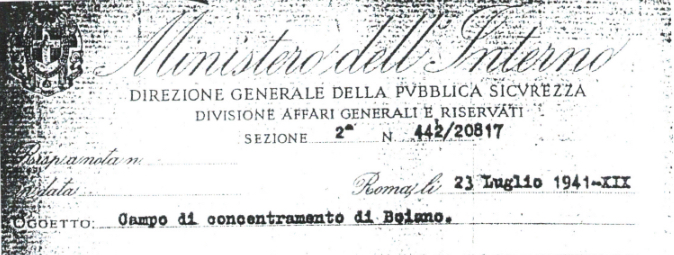
The former Saim tobacco factory, a few metres from the railway, was chosen as the site for a concentration camp in the summer of 1940. It was not immediately reserved for Roma and Sinti, although a large proportion of the deportees were ‘Gypsies’. A document about the camp indicated among other things that it could be suitable for 250 normal prisoners or 300 ‘gypsies’. Already in 1941 it seems quite clear that the Boiano concentration camp was to become the specific internment site for this category. In the police reports, at least thirty members of the Hudorovic family were all sent, from various parts of Italy, to Bojano. From 1941, the arrest of a ‘gypsy’ always indicated the concentration camp in the province of Campobasso as the destination.
On 9 April 1941, a caravan of ‘gypsies’ was stopped in the Udine area; it consisted of eight people: Antonio Suffer, his wife Genoveffa Locato and their children Cesarina, Nerina and Albino with their granddaughters Maria and Nerina Locato. Travelling with these people were two other Sinti who were also arrested: Annetta Reinardi, who had her three-year-old son Celestino with her. Annetta had Italianised her surname, but it was the Reinhardt family, originally from Germany, but who had fled to Italy at the end of the 19th century because of the persecution triggered by Alfred Dillmann, head of the Bavarian police. The arrest document concluded: ‘being socially dangerous elements, without stable employment and without a fixed abode, internment in a concentration camp is proposed’. It was 1941 and the name of the camp to which they were to be sent, noted in pencil, was Bojano where they arrived a few weeks later, escorted by the Carabinieri.
The three warehouses surrounded by fences with bars on the windows that characterised that place of imprisonment were very useful for imprisoning Roma and Sinti: in one of the three spaces the horses were left, which were then taken away by the carabinieri, while in the other areas were the kitchen, the refectory and other facilities. The camp was directed by a police commissioner and supervision was entrusted to the Carabinieri. In the summer of 1941, following a proposal to use the former tobacco factory for broom processing and therefore as a work improvement for the area, the Inspector General of the Ministry ordered the closure of the Bojano camp and to move the prisoners to other concentration camps; the Roma and Sinti (who at that time numbered 58 individuals) were all taken to the Agnone camp.
